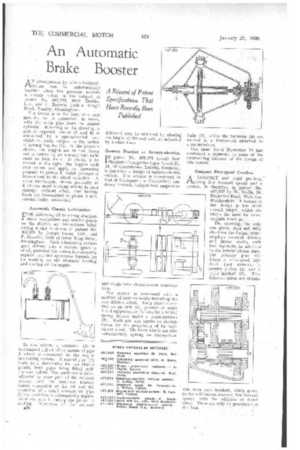An Automatic Brake Booster
Page 56

If you've noticed an error in this article please click here to report it so we can fix it.
A R6unie of Patent Specifications That Have Recently Been Published
AN arrangement by which hydraulic brakes can be automatically boosted when the pressure exceeds a certain value, is the subject of patent No. 497,226, from Bendix, Ltd., and G. Roberts, both of King's Road, Tyseley, Birmingham.
The device is in the form of a unit intended to be connected, in series, with the main pipe from the master cylinder. Referring to the drawing, a pair of opposed pistons (3 and 4) is connedted by a spring-loaded bar, which is, itself, subject to th action of sprung toggles (1). In the position shown, the toggles are at rest, being out of centre by an amount just sufficient to lock them. If piston 4 be moved, to the right, the toggles rock over centre and apply an increasing pressure to piston 3, which pressure is transmitted to the wheel cylinders. A valve mechanism, shown generally at 2, allows small braking efforts to pass through without effect, but heavier loads are transmitted to-piston 4 and, automatically, intensified.
Automatic Chassis Lubrication.
rOR delivering oil to spring shackles,
brake mechanism and similar points on the chassis, an intermittent lubricating device is shown in patent No. 497,268 by Joseph Lucas, Ltd., and P. Douglas, both of Great King Street, Birmingham. Such lubricating devices need deliver only a minute quantity of oil, provided the action is reasonably regular, ano this apparatus depends for its working on the alternate heating and cooling of the engine.
In this scheme a container (3) is maintained full of oil by means of pipe 1 which is connected" to the engine lubricating system. A second pipe (2) leads to a distributor for the chassis points, both pipes being fitted with one-way valves. The container is fitted adjacent to some part of the exhaust system, and the resultant heating causes expansion of the oil and the expulsion of a small amount via pipe 2; the container is subsequently replenished via pipe 1, during the period of cooling. Variation of the amount .63S delivered may be obtained by altering the length of the end wall, as indicated by broken lines.
German Practice in Sattery.electrics.
I N patent No. 497,078 (void) from Bleichert-Transportanlagen G.m.b.H., 15, Bleichertstrasse, Leipzig, Germany, is described a design of battery-electric vehicle. The scheme is interesting in that it illustrates the Continental tendency towards independent suspension and single-tube chassis-frame construction.
The patent is concerned with a method of independently mounting the rear driving wheel. Each wheel is carried on an arm (2), pivoted at point 1 and supported at the rear by a helical spring housed under a cross-member (3). Each arm also carries an electric motor for the propulsion of its individual wheel. The front wheels are also independently sprung on stirrup-type links (5), whilst the batteries (4) are carried in a framework attached to cross-members.
Our issue dated November 18 last contained a reference to some of the outstanding features of the design of this vehicle.
Compact Five-speed Gearbox.
ACOMPACT and rigid gearbox, giving five forward speeds and a reverse, is described in patent No. 497,257 by W. Wallis, 26, Penistone Road, Waterloo, Huddersfield. A feature of the design is the short overall length, which obviates the need for intermediate bearings.
The drawing, the only one given, does not fully illustrate the design, which employs co-axial driving and driven shafts, with two layshafts. in addition to the reverse-pinion stub. The primary gear (1) drives a slow-speed layshaft (not shown), a reverse pinion (2) and a faster layshaft (3). Two different ratios are obtain
ab e from each layshaft, which gives, in the well-known manner, 'five forward speeds, with the addition of direct drive. There are only II gearwheels in the box.




















































































